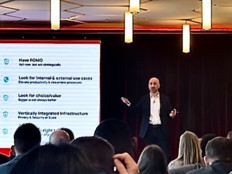“What happened last year because of the flood of loan applications is that they were really falling behind — I mean seriously,” he says. “Some small businesses wouldn’t hear back for a month or more on their applications. Now, this is where banks are trying to accelerate: through the use of RPA.”
Say a customer omits a ZIP code on an application, for example. RPA looks at the other information on the form, such as the name and address, and pulls previous customer records to identify the ZIP code, Silva says.
Using bots for manual processes such as these can reduce processing costs by 30 to 70 percent, according to one estimate. Applications are numerous in the financial services sector, from compliance and credit card processing to customer service.
Globally, the RPA market size was valued at $1.57 billion last year, and is expected to grow by nearly a third over the next seven years, data from Grand View Research shows. Companies that provide banking, financial and insurance services make up the dominant share of users of this technology, accounting for 29 percent of the market share in 2020.
“The increased financial activity due to rapid globalization has led to a rise in data volumes and transactions structured around legacy systems that are hard to integrate,” Grand View Research notes. “This demands automation solutions to enable organizations to realign their resources to focus only on high-value facing customer and strategic roles instead of repetitive tasks.”
MORE FOR BANKS: Learn how to avoid compliance issues in the cloud.
What Happens to Transformed Financial Institutions
Further digital transformation in the industry could include increasing the use of artificial intelligence to develop personalized financial plans, enhance customer relationships and automate debt collection. Institutions are also making the move to cloud services for storing data.
In the IDC white paper, Silva points to a 2020 IDC survey showing that 89 percent of banks are operating with public and private hybrid cloud solutions or are planning to. He also notes that financial institutions that had already bought in to digital transformation have been able to weather the pandemic and recover more quickly than their peers.
“For banks that are not in this position, the digital divide represents, at best, a threat to their market share and, at worst, a threat to their very existence from the banks that had already progressed further on their transformational journeys,” the white paper notes. “Transformation is a process that will last beyond the next few years as banks modernize their core infrastructures. But future transformation will be more about business innovation than about technology modernization, if the bank can accelerate its transformation strategy today.”










